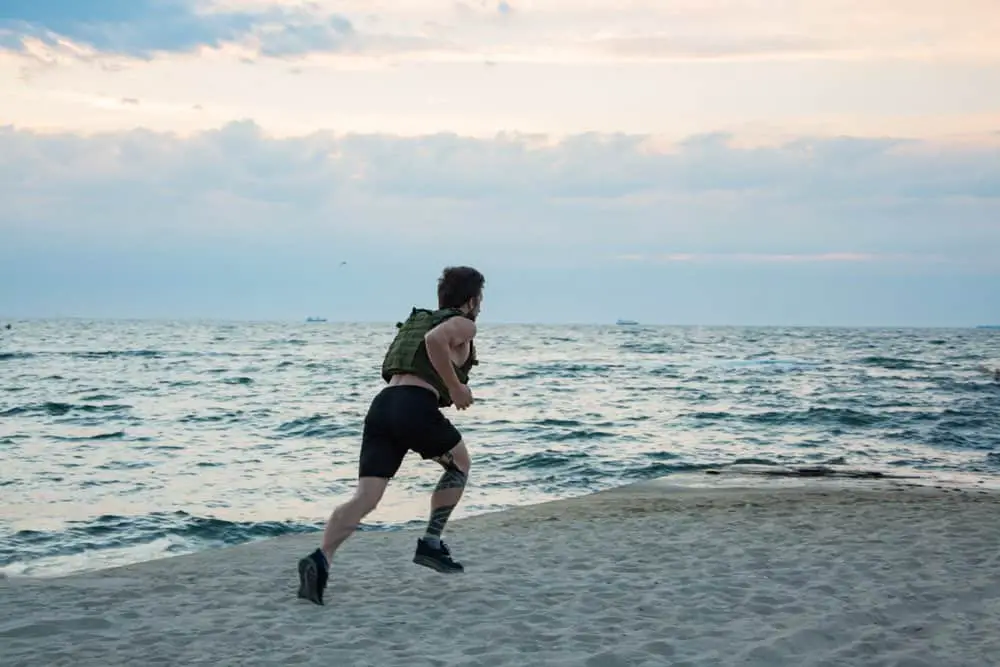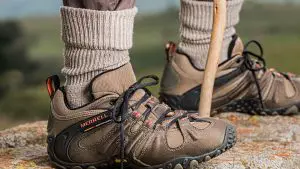Hiking With A Weighted Vest: Does It Actually Work? (2023)

Hiking is a workout routine for some, while others use it to socialize, reflect, or improve their mental well-being. For me, it’s sometimes a bit of both.
Now, hiking with a weighted vest: A stroke of genius or an invitation for back pain? Let’s dissect this. Weighted vests are gaining popularity faster than you can say ‘fitspiration.’ Fitness enthusiasts swear by them, but are they of any real value when it comes to hiking?
In this article, we’ll weigh in (pun intended) on the benefits and the potential pitfalls of strapping on some extra pounds while hitting the trail. We’ve also got handy advice on how to incorporate a weighted vest into your hike without looking like a medieval knight. Let’s dive in!
Quick Links
Benefits of Hiking with a Weighted Vest
So, you’re into hiking, huh? Great stuff. But have you ever fancied strapping on a weighted vest while you’re tackling those trails? Sure, it may sound like a game of Truth or Dare gone wrong, but hear us out — there’s a handful of legit benefits for your fitness and overall health. So let’s start with the benefits:
Increased Muscle Building and Strength
Here’s the thing, by hiking with a weighted vest, you’re adding literal resistance to your wanderlust adventures. Your muscles have to put in overtime with the added weight, so what’s the result? BOOM — bigger muscles and better overall strength for your entire body.
Improved Cardiovascular Health
Think of hiking with a weighted vest like hiking on steroids. Your heart rate cranks up, your cardio workout intensifies, your lung capacity expands, and your endurance becomes like that Energizer Bunny everyone’s always talking about.
Enhanced Balance and Coordination
Ever wonder what it’s like to hike on the moon? Okay, a weighted vest isn’t quite that, but it does mess with your balance and coordination just like low gravity would. The extra weight changes your center of gravity and your body has to adapt to stay upright. It’s tricky at first, but with time, you’ll become an agile ace on any trail.
Tips for Hiking Safely with a Weighted Vest
Okay, so now you’re thinking of trying out hiking with a weighted vest? Good on you! It’s a great way to up the ante of your usual hiking workouts. But hold on, there are some things to keep in mind to make sure you’re not only challenging yourself but staying safe too. So here are the golden rules:
- Beginner? Go light: If you’re a newbie, don’t go all out with the heaviest vest. Start off light and let your body get used to the change.
- Add weight slowly: Once you’re ready, increase the weight slowly over time. You want your muscles and heart to adjust gradually. Trust us, your body will thank you.
- Posture is key: Keep your back straight and engage those core muscles — trust me, it will help you balance and prevent a sore back later.
- Pace yourself: Remember, you’re not in a race. Hiking with a weighted vest can be tough, so go at a pace that feels good for you. No need to push your limits, especially at the start.
- Hydrate, hydrate, hydrate: With a weighted vest, expect to sweat more. And you know what that means, right? Chug that water to stay hydrated throughout your hike!
Stick to these tips and you’ll not only reap the benefits of hiking with a weighted vest, but you’ll also keep injuries at bay and maximize your workout.
Now let’s get into a bit more detai.
Go for Lightweights
If you are just starting out, it’s best to begin with lightweight weighted vests. These vests typically have 2-5 pounds of weight, which is enough to challenge your body without being too strenuous.
As you become more accustomed to hiking with weights, you can gradually increase the amount of weight in your vest.
Start Slow
When beginning any new workout routine, it is essential to start slow. This is especially true when hiking with a weighted vest. Start by adding just a few pounds of weight to your vest and gradually increase the amount as you become more comfortable.
This will help minimize the risk of injury and allow your body to adjust to the added weight.
No Lengthy Walks
Regardless of your hiking experience level, when you start using a weight vest while hiking, you’re gonna want to keep your walks short.
Start with about 10 to 15 minutes and increase the duration as your body adjusts to the additional weight. If you are hiking in a warmer climate, you need to consider all the extra warmth the heavy layers add to your body.
Heat stroke is serious and can sometimes be fatal – so make sure to give your body time to breathe and cool down regularly.
Drink Plenty of Water
It is essential to drink plenty of water while hiking, especially when wearing a weighted vest.
The extra weight makes you sweat more, so it’s important to stay hydrated at all times. Carry a water bottle with you and drink frequently, even if you don’t feel thirsty.
Watch Your Posture
Maintaining correct posture when walking with weights is the best way to reduce your risks of injury. While correct posture is always important, I cannot overemphasize its importance with added weight on your back.
Stand straight, keep your shoulders relaxed, and footing light.
Does Hiking with A Weighted Vest Build Leg Muscle?
Looking for some extra edge in your workout? Perhaps you’ve cast your eye on a weighted vest and have wondered just how it could be the gym rat you need on your trail.
The short answer? It’s all about cranking up the intensity and showing your leg muscles who’s boss.
Distribution of Weight on the Legs
Immediately you strap on that weighted vest, your legs start calling a meeting. Why? Because the extra weight from the vest makes every bit of your leg work harder on each step you take.
The extra pounds get evenly distributed on your body, with a considerable part shouldered (or rather ‘legged’) by your legs.
The result? Your leg muscles get a serious wake-up call, leading to a pumped-up workout.
Muscle Mass Development
And did you know? Resistance, while initially a bit of a hassle, is actually your muscles’ best mate. The added resistance from your weighted vest has your muscles creating a welcome mat for growth and development.
With each weighted step you take, your muscles roll up their sleeves and take on the extra weight, recruiting more muscle fibers like they’re on a scout mission.
This effectively strengthens the leg muscles over time so you can say ‘hello’ to leg day every day, on (and off) the trail.
Is a Weighted Vest or Backpack Better?

Planning a hike and can’t decide between a weighted vest and trusty ol’ backpack? Stick with us as we dive in and compare how these two fair in the wild unknown.
The Good, The Bad, and The Sweaty
On one hand, we have weighted vests. These bad boys hug close to your body, balancing the weight evenly across your torso. Great for stability and not overworking any particular muscles.
But the drawbacks? Well, your carrying capacity gets a drastic cut, and let’s just say, there’s definite potential to sweat off a litre or two.
Enter backpacks. These familiar friends offer plenty of space for the hiking essentials (snacks, anyone?). Their secret is dispersing the weight across your shoulders and hips for an even load.
But watch out – Improperly fitted backpacks could give you some serious back and shoulder cramps.
Load Placement – The Weighty Argument
If we’re talking weight distribution, weighted vests take the win. The load sits right on your torso, simulating the feel of extra body weight. You’ll definitely feel the burn in your legs and core — an intense hike awaits!
Backpacks, by contrast, spread the weight between your back, shoulders, and hips. Not as challenging, but you’ll still get a good workout!
The Posture Postulate
Both the weighted vest and the backpack have a say on how straight you stand during your hike. Thanks to the weight centered around your torso, vests tend to promote an upright posture, and that can help improve your overall balance.
Backpacks, when adjusted and loaded perfectly, also encourage good posture by distributing the weight evenly and allowing you to walk naturally.
So, who comes out as the hiking champion — the weighted vest or the backpack? Well, that all depends on you, really. If you’re chasing a gruelling workout and fancy your balance skills, the weighted vest has got you covered.
However, if you’re all about carrying capacity and convenience, the backpack is your best bet.
Calorie Burn and Weighted Vest Hiking
Want to zap calories like a superhero while hiking? Just slide into a weighted vest. Think of it as your secret weapon or, if you will, your magic cape to supercharge your workout.
Increased Calorie Burn
Hiking with a weighted vest is like having a nemesis pushing against you, resulting in mega resistance, which makes your muscles go the extra mile (literally). Hello, higher calorie burn!
Studies spill the beans — acordding to The American Council on Exercise, wearing a weighted vest can catapult your calorie burn by a whopping 10-15% compared to your regular, unadorned hikes.
So, if melting extra calories and shedding pounds is on your checklist, a weighted vest can be just the ace up your sleeve.
Optimal Weight Percentage for the Vest
Equipping yourself with the right weighted vest is like choosing the perfect sidekick — it has to match your powers. Consequently, picking a vest that weighs 5-10% of your own weight is a smart place to start.
This balance allows you to enjoy the thrill of the added challenge, without your knees shouting “Hey, what did we do to you?” as they bear the extra load. As your strength grows, you can amp up the weight of your vest for those extra bragging rights.
So, if you’re ready to turbocharge your hikes and let the calorie sparks fly, strap on a weighted vest. Ultimately, It’s just a sly little device to add more punch to your hike while enjoying the spoils of extra calorie burn.
What’s the Best Weighted Vest for Hiking?

The Aduro Sport Weighted Vest is my recommendation for the best weighted vest for hiking. It goes up to a maximum of 30 lb and has a minimum of 4 lb.
It’s made with comfortable neoprene material and contours to your body. The vest has hypo-allergenic iron fillers instead of the typical sand that’s often used.
Lastly, it’s small, so it’s not obtrusive. You can comfortably wear clothes on top of it. Before this, I had an adjustable vest I bought from Academy Sports Outdoors, which I thought was great – until the bulk started to get in the way and became a nuisance.
Conclusion
So, hiking with a weighted vest, huh? Sure, it cranks your workout up a few notches, gives your muscles a solid run for their money, boosts cardio health, and sharpens up balance and coordination.
But remember, you gotta do it right. Start with a lighter vest, slowly stack on the weight, keep your posture pretty, watch your pace, and stay hydrated. Got it?
Now, when it comes to choosing between a weighted vest and a backpack — well, that’s tricky. Weighted vests distribute the weight evenly across your body, giving your legs a killer workout. Backpacks, on the other hand, are great for hauling your stuff. Ideally, look for a comfy weighted vest with a weight range that works for you, (we’re fans of the Aduro Sport Weighted Vest, just saying).
At the end of the day, hiking with a weighted vest can totally intensify your workout and help you smash your fitness goals.
Just don’t forget to listen to your body, take a break if you need to, and enjoy the thrill of those different hiking trails with your weighted vest. Happy hiking!
Frequently Asked Questions
Can a weighted vest hurt your back?
No, a weighted vest should not hurt your back if you use it properly. Always start slowly and with lighter weights to build resistance. If you experience pain, stop and consult a doctor.
Is it better to hike with a backpack or weighted vest?
Excluding functionality – Hiking with a weighted vest is generally better than hiking with a backpack. This is because weighted vests evenly distribute weight on your body, whereas backpacks do not. Backpacks can also be bulky and hinder your movement.
Do weighted vests stunt your growth?
No, weighted vests do not stunt your growth. In fact, they can help improve your posture and spine health. However, as with any workout routine, be mindful of your limits and always consult a doctor before starting any new exercises.
How heavy should a weighted vest be for walking?
A weighted vest should be heavy enough to challenge you, but not so heavy that it hinders your movement or causes pain. A good starting point is a vest that is 10% of your body weight. You can gradually increase the weight as you build resistance.







